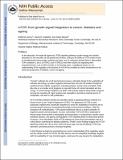mTOR: from growth signal integration to cancer, diabetes and ageing
Author(s)
Zoncu, Roberto; Efeyan, Alejo; Sabatini, David
DownloadSabatini_mTOR from.pdf (2.737Mb)
OPEN_ACCESS_POLICY
Open Access Policy
Creative Commons Attribution-Noncommercial-Share Alike
Terms of use
Metadata
Show full item recordAbstract
In all eukaryotes, the target of rapamycin (TOR) signalling pathway couples energy
and nutrient abundance to the execution of cell growth and division, owing to the ability of TOR protein kinase to simultaneously sense energy, nutrients and stress and, in metazoans, growth factors. Mammalian TOR complex 1 (mTORC1) and mTORC2 exert their actions by regulating other important kinases, such as S6 kinase (S6K) and Akt. In the past few years, a significant advance in our understanding of the regulation and functions of mTOR has revealed the crucial involvement of this signalling pathway in the onset and progression of diabetes, cancer and ageing.
Date issued
2010-12Department
Massachusetts Institute of Technology. Department of Biology; Whitehead Institute for Biomedical ResearchJournal
Nature Reviews Molecular Cell Biology
Publisher
Nature Publishing Group
Citation
Zoncu, Roberto, Alejo Efeyan, and David M. Sabatini. “mTOR: From Growth Signal Integration to Cancer, Diabetes and Ageing.” Nature Reviews Molecular Cell Biology 12.1 (2010): 21–35.
Version: Author's final manuscript
ISSN
1471-0072
1471-0080